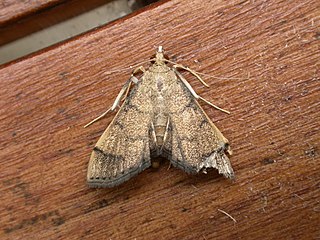
The Pyralidae, commonly called pyralid moths, snout moths or grass moths, are a family of Lepidoptera in the ditrysian superfamily Pyraloidea. In many classifications, the grass moths (Crambidae) are included in the Pyralidae as a subfamily, making the combined group one of the largest families in the Lepidoptera. The latest review by Eugene G. Munroe & Solis, in Kristensen (1999) retains the Crambidae as a full family of Pyraloidea.

The Pyraloidea are a moth superfamily containing about 16,000 described species worldwide, and probably at least as many more remain to be described. They are generally fairly small moths.

The Pyralinae are the typical subfamily of snout moths and occur essentially worldwide, in some cases aided by involuntary introduction by humans. They are rather rare in the Americas however, and their diversity in the Australian region is also limited. Altogether, this subfamily includes about 900 described species, but new ones continue to be discovered. Like many of their relatives in the superfamily Pyraloidea, the caterpillar larvae of many Pyralinae – and in some cases even the adults – have evolved the ability to use unusual foods for nutrition; a few of these can become harmful to humans as pests of stored goods.

Callionyma is a monotypic snout moth genus. Its one species, Callionyma sarcodes, was described by Edward Meyrick in 1882. It is found in the southern half of Australia, including Tasmania.
Analcina is a monotypic genus of moths of the Cybalomiinae subfamily of the Crambidae. It contains only one species, Analcina penthica, which is found in Australia, where it has been recorded from Queensland.
Aporocosmus is a genus of moths of the Sterner family. It contains only one species, Aporocosmus lamprodeta, which is found in New Guinea and Australia, where it has been recorded from Western Australia, the Northern Territory, Queensland and New South Wales.
Araeomorpha is a genus of moths of the family Crambidae.
Glauconoe is a genus of moths of the family Crambidae. It contains only one species, Glauconoe deductalis, which is found in Australia (Queensland), New Guinea, Sri Lanka and Taiwan.
Neargyrioides is a genus of moths of the Crambidae family. It contains only one species, Neargyrioides aglaopis, which is found in Australia, where it has been recorded from the Northern Territory and Queensland.

Parapoynx fluctuosalis is a moth of the family Crambidae. It is a widespread species, known from Africa, India, Sri Lanka, China, Japan, Malaysia, Taiwan, Guam, Hawaii, Fiji, Australia and the Galápagos Islands. It is also an introduced species in Europe, where it has been recorded from Great Britain, the Iberian Peninsula and Sardinia.

Pyralis manihotalis is a moth of the family Pyralidae described by Achille Guenée in 1854.

Hypsopygia mauritialis is a moth of the family Pyralidae described by Jean Baptiste Boisduval in 1833. It is a widespread species, known from Africa, India, China, Malaysia, Taiwan, Japan, Australia and Hawaii.

The Phycitini are a tribe of moths of the family Pyralidae.

Omiodes indicata, the bean-leaf webworm moth or soybean leaf folder, is a species of moth of the Crambidae family. It is found from Florida to Texas, the West Indies and Mexico to South America, Cameroon, the Comoros, the Democratic Republic of Congo, La Réunion, Madagascar, Mauritius, Nigeria, Saudi Arabia, the Seychelles, South Africa, India, Borneo and Australia (Queensland).

The Anerastiini are a tribe of moths of the family Pyralidae.

Pyrausta phoenicealis, the perilla leaf moth, is a moth of the family Crambidae described by Jacob Hübner in 1818. It is found worldwide, including the Americas, Africa, Australia and Asia.
Ancylolomia westwoodi is a moth in the Crambidae family. It was described by Zeller in 1863. It is found in Afghanistan, Iran, western Pakistan, India, Sri Lanka, Sulawesi, Java, Bali, Malaysia, Sumatra and Australia, where it has been recorded from the Northern Territory and Queensland.
Ubida holomochla is a moth in the family Crambidae. It was described by Turner in 1904. It is found in Australia, where it has been recorded from Queensland and the Northern Territory.
Trigonoorda trygoda is a moth in the Crambidae family. It was described by Meyrick in 1897. It is found in Australia, where it has been recorded from Queensland, New South Wales and Western Australia.

Leucinodes cordalis, the poroporo fruit borer or eggfruit caterpillar, is a species of moth in the family Crambidae. It is found in New Zealand, Australia and Indonesia (Sulawesi). In Australia, it has been reported from Norfolk Island, the Northern Territory, Queensland, New South Wales, the Australian Capital Territory, Victoria, Tasmania and South Australia. The species was first described by Henry Doubleday in 1843.













